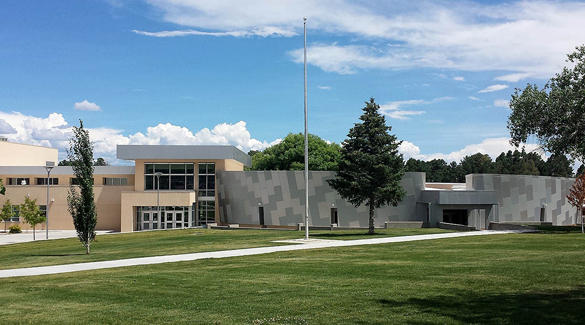 Los Alamos High School. Photo by Kevin Parkinson
Los Alamos High School. Photo by Kevin Parkinson
By KEVIN PARKINSON
LAHS Student
Los Alamos Public Schools is the number one school district in New Mexico, but how does it rank in energy usage and sourcing? Surprisingly well, a local student finds.
I am a junior at Los Alamos High School, and I feel fortunate to attend an institute of such high merit. When I was challenged in an online environmental competition, the Project Green Challenge, to find out how well my school used energy, I eagerly accepted. I have fond memories of instances where the school system has given me opportunities to learn about sustainable energy, and I was sure I could prove that my school was energy smart.
To begin my quest, I emailed Dr. Kurt Steinhaus, the school superintendent, asking for information. He put me in contact with Curtis Terrill, a staff member at LAPS, who was gracious enough to give me files on the high school’s energy, water and gas usage on meters representing the campus’s main building.
Last year in that area of campus, the average daily electricity usage was 1,932.78 kilowatt-hours, the average daily gas usage was 117.98 therms, and the average water usage was 0.05 kilogallons. These values are part of an overall downward trend that can be observed by plotting use per day over the billing period for the last 10 years. For those meters at least, it can be seen that Los Alamos Public Schools is reducing its use of these precious resources.
But is the electricity, water and gas that the schools use clean? They are supplied by Los Alamos County, so a look at the County’s online public utility page can help answer this question.
In regard to Los Alamos’s primary energy supply, 46 megawatts of the county’s electricity comes from coal and 27 megawatts come from hydropower. We also get one megawatt of power from right here in Los Alamos, from the photovoltaic array at the landfill! Our gas comes from national sources, and our water is groundwater pumped from an aquifer under the Pajarito Plateau. The DPU is trying very hard to incorporate more renewable energy sources into the local supply and be conservative with the water supply, with a number of programs working toward improvement.
From there, I moved my search onto the Internet, where I looked for information that would confirm my inference that LAPS is reducing its overall resource consumption, and to learn about any green energy initiatives being undertaken. I found two articles that gave me the information I was looking for.
An article posted on the LAPS News Page in 2010 reveals that the school system formed a strategic alliance with Energy Education, an energy conservation company, and saved more than $1 million in energy costs over a 56 month period. How can this give us confidence today? At the time, the founder and CEO of Energy Education had this to say: “Strong support [from LAPS has] created an atmosphere of cooperation that should continue to grow and ensure even greater success well into the future”.
Another article from New Mexico’s Energy, Minerals and Natural Resources Department tells of a grant awarded to the Los Alamos Public Schools for the installation of photovoltaic electric systems. To receive this grant, the school had to go through a competitive application process. The resulting array can be found at Los Alamos Middle School on North Mesa. This example shows how the school system is willing to jump on opportunities to provide renewable energy sources, and to educate students about them.
Students in Los Alamos, “where discoveries are made”, can rest assured that their schools will do their best to ensure that they have a school where they can go to learn with confidence that steps will continually be made by their institutions to ensure that their future is safe. Perhaps one day, one of these bright pupils will pay back their alma mater, by making “a discovery” leading to a bright future powered by clean energy.
Editor’s note: Kevin Parkinson was suppose to write an article about his high school’s energy usage and get it published in his school paper for an online competition. The problem is LAHS doesn’t have a school paper so he asked to have his article published in the Los Alamos Daily Post.

